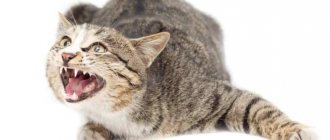Plague or panleukopenia: Features
Feline distemper or panleukopenia is an infection of the body by a virus called parvovirus.
It has amazing resistance to high and low temperatures, so this disease affects both winter and summer. When an animal becomes infected with parvovirus, the number of white blood cells in its blood decreases, and the infection also affects the lymphatic system.
Very often, cats do not survive distemper, and the most dangerous period of infection occurs in spring and autumn, when the animal breeds.
It is important to know that people are not susceptible to this disease, so it is impossible to get infected from a pet.
The main danger of the disease is as follows:
- It is quickly transmitted from a sick cat to a healthy one;
- Has a mass character;
- Has a high mortality rate;
Parvovirus is shed in stool, urine and saliva.
Pathogen and its features
The causative agent of panleukopenia belongs to viruses from the Parvoviridae family and is related to the causative agent of canine parvovirus enteritis. It is characterized by a rather small diameter of 20-25 nm, the absence of a shell and the presence of one DNA helix, as well as high stability in the environment.
The virus, like other members of the Parvovirus family, is very resistant to high temperatures and survives for an hour when heated to 60 degrees. Remains stable in both alkaline and acidic environments. Difficult to use with conventional disinfectants. In the environment, in the feces and organs of sick animals at low temperatures, it can persist for more than 1 year. When entering the body, the virus first of all affects the cells of the mucous membrane of the gastrointestinal tract, and then, as the infection develops, it damages other organs and tissues, including the hematopoietic organs, which leads to a decrease in the number of white blood cells (leukopenia).
How does infection occur?
Panleukopenia is transmitted quickly and in several ways.
- Airborne - a cat that has had distemper remains infected for another twelve months and can spread the disease.
- Contact method - occurs through the secretions of a sick animal, which enter the mucous membrane of a healthy cat.
- The transmission route is through the bites of ticks and fleas that have been in contact with a sick animal.
- Prenatal birth - kittens in this case do not survive.
- Mother's milk from a sick cat also infects newborn kittens.
Although people cannot contract panleukopenia, they can spread the disease on clothing or shoes.
What can panleukopenia be confused with?
Firstly, with poisoning. An important difference between panleukopenia and poisoning is that with this disease, at the initial stage of the disease, the animal’s body temperature rises significantly, up to 40-41 degrees and above. In case of poisoning, the temperature is normal or low. However, kittens quickly enter the second phase of the disease - exhaustion of the body, during which the temperature drops. In this case, only a veterinarian can distinguish between these two conditions.
Secondly, with acute toxoplasmosis. Most often, this infection is carried by cats asymptomatically, but in kittens it is difficult to distinguish between these two infections by symptoms. This is where express analysis or PCR comes to the rescue. Toxoplasmosis in kittens, although severe, is less dangerous than panleukopenia. There is a specific treatment for this disease, that is, drugs that kill the pathogen.
Thirdly, with pancreatitis, acute gastroenteritis of non-viral nature and other diseases of the gastrointestinal tract. With these diseases, the temperature may rise, but the pathogen will not be identified, and in small kittens they are all quite rare.
Symptoms of infection
To prevent the death of your pet, you need to learn to recognize the signs of distemper in cats in order to begin treatment as quickly as possible. The incubation period of the disease ranges from six to twelve days; it develops very quickly and affects the body.
The obvious symptoms of distemper are caused by intoxication and dehydration; the cat's temperature rises, digestion is disrupted and difficulty breathing occurs.
Panleukopenia has several forms, which can be used to determine the course of the disease.
- Lightning form - this form most often attacks animals under one year of age. The pathology develops so quickly that the animal dies almost instantly. The cat refuses food and water, does not show physical activity, and trembling limbs appear.
- The acute form affects adult cats. The cat develops vomiting and diarrhea, abdominal pain, decreased motor activity, lacrimation, increased temperature, and rapid heartbeat. From the photo of distemper in cats you can see what a sick animal looks like.
- Subacute form - it has the same symptoms as the acute one, but their expression is weaker. In this case, treatment of panleukopenia occurs quickly, without negative consequences.
What is feline panleukopenia?
“Chumka” is a popular name. This is the name given to various infections that are characteristic of different types of animals, but have common features - they are very contagious, sick cats often die or have a difficult recovery. In addition, cat distemper is sometimes similar in its course to canine distemper, to which dogs are susceptible. Until 1928, it was even believed that these were the same disease, but their pathogens were different, and cats did not get canine distemper, and vice versa.
The causative agent of the disease is the Panleukopenia feline virus , which belongs to the parvovirus family. Veterinarians and virologists call feline distemper panleukopenia, or infectious gastroenteritis.
The first scientific name describes a characteristic symptom of the disease - a significant decrease in the number of all types of leukocytes in the animal’s blood. The second is a set of symptoms noticeable to the owner: this is an upset stomach and intestines, moreover, caused by an infection, that is, contagious.
It would seem, how is the decrease in the number (up to complete absence!) of leukocytes in the blood connected with inflammation of the gastrointestinal tract? The fact is that the causative agent of panleukopenia needs cells that divide as quickly as possible to reproduce. And these are bone marrow cells, especially those that produce leukocytes (at first the virus causes accelerated production), epithelial cells of the stomach and intestines, fetuses and newborn kittens. But since division is a process characteristic of cells of any tissue of a living organism, the disease actually affects all organs.
Diagnosis of the condition
At the slightest suspicion of distemper, you must immediately contact a veterinary clinic to carry out all tests and immediately begin treatment. The sooner treatment begins, the greater the chance of saving your pet.
The following studies are being carried out:
- Mouth and nose swab;
- Stool analysis;
- Blood test for the number of leukocytes;
Differential diagnosis is also carried out. The diagnosis is made based on history, examination, laboratory and clinical tests.
Diagnosis of panleukopenia in kittens
The stages of diagnosing panleukopenia in kittens are the same as in adult animals: general examination, tests for virus content, clinical blood test. However, the difficulty of testing in kittens is to take the required amount of blood. Animals are already dehydrated, and their hematopoietic system suffers. It is not always possible to draw blood even when an intravenous catheter is placed. It is possible to collect from the jugular vein, but this manipulation requires specific skills from the doctor and is not performed by all veterinary specialists.
PCR diagnostics (detection of panleukopenia virus DNA) in kittens is necessary if an express test is not available. The analysis takes 2-3 days, and there is a chance that the animal will not live to see the result. But it is necessary to know the cause of the disease, because more than once in veterinary practice there have been cases when owners brought dying kittens to the clinic one after another: 2-3 months after the death of the pet, they took in a new animal, and at home it became infected with a fatal disease from its predecessor.
The panleukopenia virus is extremely stable in the external environment; it remains viable for up to 1 year. Therefore, it is unacceptable to take a new cat into the house without antiviral treatment of the premises and objects.
Modern rapid tests are almost as accurate as PCR. Suitable material for both methods is stool or intestinal washings, which allows you to collect less blood for analysis or delay blood testing if collecting it is difficult due to the patient's serious condition.
Correct treatment
Once the diagnosis has been established, treatment for distemper in the cat begins, which should be prescribed by a veterinarian. The animal is prescribed medications that help alleviate its condition.
- Painkillers
- Antihistamines
- Antiviral and immunomodulators
- Medicines that remove toxins
- Antibiotics
- Medicines to support heart function
- Means for normalizing metabolic processes
It is also important to give your cat vitamins that contain folic and ascorbic acid. To cause an increase in urine output, herbal preparations can be used.
Forms of the disease
Depending on which organs are most affected by the virus of this infection, panelelukopenia in cats occurs in the nervous, intestinal, skin, mixed, and atypical forms.
As already noted, the symptoms of a viral disease largely depend on the stage at which the viral disease occurs, as well as on the form of the disease.
Intestinal (gastroenteral) form of feline distemper
The main symptoms of the intestinal form of panleukopenia are manifested in disruption of digestive processes and the functioning of the gastrointestinal tract. In addition to the high temperature and general weakness, the animal refuses food and food, and quickly loses weight. Thirst is increased, but the cat cannot drink water due to spasms of the larynx. Salivation and signs of rapidly increasing dehydration and dehydration are noted.
A characteristic sign of the intestinal form is bloody, foul-smelling, profuse diarrhea. The cat experiences pain when defecating. The tummy is enlarged. On palpation of the peritoneum, a rounded swelling is clearly felt. These are enlarged intestinal lymph nodes.
There is a lot of mucus, foam in the stool, there are bloody clots, inclusions, and threads. White fibrin flakes are visible in the urine. The color of urine is dark orange.
Respiratory, pulmonary form
The pulmonary form in cats may also have manifestations that are characteristic of other forms of infection. Most often it occurs acutely, subacutely.
If the virus provokes an infection of the upper or lower respiratory tract, or affects the lungs or bronchi, the cat’s viral illness manifests itself as symptoms of an acute respiratory infection. Due to inflammation, the temperature rises by 1-2 degrees, after which it returns to normal after a while.
Prolonged attacks of dry cough, coughing, shortness of breath, shallow rapid breathing, mucous, mucopurulent discharge from the eyes, nose, pale mucous membranes, apathy, weakness, drowsiness. These are the main manifestations of the pulmonary form of panleukopenia in sick cats.
Animals suffer from severe thirst, especially when the temperature rises. The cat is lethargic and apathetic. When auscultating (listening) of the sternum, wheezing and whistling sounds are clearly audible. The mucous membrane of the larynx and bronchi is severely inflamed. The nose is hot and dry. Dry gray crusts are visible on the lobe. The cat has no appetite, but may be thirsty.
Important! If treatment is not started in time, the infection provokes pulmonary edema. The animal falls into a coma and may die.
The pneumonic form of distemper in sick animals is accompanied by attacks of nausea and debilitating vomiting. Vomit may contain mucus, foam, or bloody substances.
If treatment is not started, the infected animal will develop bronchopneumonia, tracheitis, bronchitis, and viral conjunctivitis.
Nervous form
This is the most severe and dangerous form of panleukopenia for furry pets, which is accompanied by complications in the functioning of the nervous system and can lead to the death of the animal. The incubation period lasts no more than 2-4 days.
The cat's behavior changes significantly, which manifests itself in an inadequate reaction to external stimuli. Animals are frightened by sharp sounds and noises. The cat can show aggression and does not make contact with humans. The stage of excitement is replaced by sharp apathy, depression, and lethargy.
In the nervous form, the virus affects the cellular structures of the muscles, which leads to sudden convulsions, paresis, and paralysis. Appetite is absent or greatly increased. In this case, the cat may show interest in inedible objects.
Photophobia, a decrease in the pupil's reaction to light, a sharp increase and then a decrease in temperature, loss of coordination, disorientation in space, rapid heartbeat, breathing, copious discharge from the eyes and nose are also symptoms of the nervous form of plague.
The severe nervous form leads to inflammation of the meninges, meningitis, encephalitis, and has other serious consequences.
Cutaneous form
With the cutaneous form of viral distemper in cats, deterioration of the coat is noted, the appearance of a rash, small red, dark brown spots near the croup, on the sides, and tummy. Small pustules, wounds, and ulcers are visible on the cat’s body, which are gateways for the penetration of pathogenic flora. In this case, acute inflammation of the upper and deep layers of the dermis develops.
The skin form of the viral disease, although it poses a danger to pets, is not as severe as, for example, the intestinal, nervous, or pulmonary forms.
Mixed form of plague
With this form of panleukopenia, sick cats experience symptoms that are characteristic of all forms of this infection. Most often, the incubation period ranges from five days to two weeks.
The most common mixed form of the disease in infected individuals is manifested by a combination of symptoms of skin and respiratory infections, nervous and pulmonary.
The healing process
After the process of treating distemper in a cat at home with medications was carried out, the animal is recovering.
The number of leukocytes in the blood normalizes, the cat gains weight, and body temperature normalizes. Sometimes panleukopenia leaves consequences for life - chronic disorders of the heart and lungs, as well as nervous diseases.
During treatment it is necessary:
- Place the pet in a warm room;
- Shade the room from sunlight;
- Ventilate and do wet cleaning daily;
- Give your cat plenty of warm boiled water;
- Use cotton swabs to remove discharge from the eyes and nose;
The well-known folk method of treating distemper in cats with vodka does not produce results and can even worsen the pet’s condition. It is better not to conduct such experiments and immediately contact a veterinarian for proper treatment.
How does the virus work?
After the distemper virus enters the cat’s body, it spreads throughout the body through the lymph. Afterwards, absolutely every system of the animal’s body is affected – digestive, nervous, bone marrow and others.
In an adult cat, the first symptoms appear seven days after infection. However, in a small kitten, whose body is smaller and whose immune system is weaker, the first signs are noted two days after infection.
Try to carefully observe the behavior of your pet predator. Any change in behavior can lead to big problems. As soon as you notice something strange, go to the vet immediately.
Prevention of plague
To avoid this dangerous disease, it is necessary to vaccinate the animal. Only completely healthy pets can be vaccinated; kittens under two months old, as well as pregnant, lactating and unhealthy cats cannot be vaccinated. Vaccination should be carried out once a year.
It is important to know that if the pet still dies from panleukopenia, you cannot get another cat for one year. You need to get rid of the dead pet's old things and toys.
Before vaccination, it is also necessary to carry out treatment against helminths and external parasites. You should not skip preventive examinations with a veterinarian and carry them out at least twice a year.
Consequences, life expectancy
The prognosis for the nervous, respiratory, and intestinal forms of feline distemper is severe or unfavorable. Much depends on age, individual characteristics, the condition and activity of the immune system, as well as how quickly treatment was started.
The most severe for kittens and adult pets, as we have already noted, is the nervous form of panleukopenia. After treatment, symptoms periodically appear over several months, years, or throughout life. Lameness, epileptic seizures, convulsions, muscle weakness. All these manifestations and consequences of infection significantly reduce the quality and life expectancy of pets.
Cats that have recovered from the disease develop specific immunity, but within 6-12 months, even a fully recovered animal is a virus carrier and can release a minimal amount of the virus into the environment. Therefore, to prevent possible infection of healthy pets, after treatment it is better to isolate the cat from other pets.
Photo of a cure for distemper in cats
How to cure feline distemper?
Today, almost any animal is at risk of an infection such as distemper. However, there is no special magic drug. Therefore, treatment for distemper is prescribed only by a veterinarian and only after a careful examination of the cat. Taking into account the symptoms caused and the severity of the disease, the doctor chooses an individual course of treatment.
Without special education, there is no need to self-medicate, relying only on information from different sources. This can cause the opposite reaction in the body. In this case, treatment of plague may require the administration of drugs using a dropper . To restore cellular balance, intoxication and dehydration, drugs containing salt, various antibiotics and vitamins, and products with a high glucose content are used.
Support of blood vessels and heart, as well as pain relief, is provided by antihistamines. Medicines are also used to enhance immunity. Sometimes there may be cases when intestinal lavage helps to overcome the disease . The course lasts 1–2 weeks. Treatment time will depend on the condition of the animal.
It is necessary to complete the full course prescribed by the veterinarian, even when the cat appears healthy at first glance. The treatment process must be carried out under the supervision of a doctor so that, if necessary, it can be corrected in time.
How to behave during treatment?
During the treatment process, you need to constantly ventilate the room. During this time, it is advised to move the cat to another room. also need to disinfect the room with a sodium hypochlorite solution or an ultraviolet lamp, do not scold the cat for uncontrollable vomiting and bowel movements, but clean everything up immediately.
If necessary, you will need to clean the muzzle, nose and eyes from viral secretions of the infection with a gauze swab treated with a preparation that the veterinarian will recommend. The temperature in the room in which the sick animal is located should not be very low and not very high. In other words, the room must be warm.
It is also necessary to avoid direct sunlight and periodically perform wet cleaning. You cannot force water or feed a cat . The animal itself will begin to eat food when the body begins to recover.
It is advisable to give light food during treatment. There is no need to burden your cat with heavy food. Feed in small portions 4-5 times a day. You can offer your cat low-fat meat broth , cottage cheese or yogurt. After a few days, you can give the cat white sea fish and dietary meat, cut into small pieces.
Vegetables, herbs and cereals are strictly prohibited from being given to a cat. Food must be at room temperature. After recovery is complete, it is advisable to feed the cat dietary products for 3 months.
Treatment goals
Since the world has not yet invented a cure for plague, the main task of treatment is to prevent a sharp decrease in immunity. The veterinarian tries to prevent the infection from multiplying, as well as the addition of bacterial diseases . Maintaining electrolyte balance and combating dehydration with IVs is also a very important task. Treatment to maintain immunity is based on drugs and antibiotics.
How to prevent feline distemper?
How to take care of an animal and behave correctly? How to cure distemper in cats? To prevent these issues from bothering you, the easiest way is to prevent the formation of the disease . A special product can help with this; its effect lasts for one year and protects the cat from many infectious diseases. Then repeated revaccination is required.
Moreover, kittens need protection from infectious diseases, since their immunity is quite weak. Kittens are required to be vaccinated twice, in the first year, starting at 2 months . It is recommended to do the first vaccination at 2 months, and the next at 3 months. The most important thing is that no more than 3 weeks pass between vaccinations.
An adult who is more than a year old needs one vaccination annually. Today it is possible to make complex vaccines from domestic and foreign manufacturers. The cat owner independently selects the most suitable drug . The main thing to remember is that before vaccination you need to do deworming, treatment for worms and other parasites. Because an animal with worms is weakened, which causes negative consequences after vaccination.











